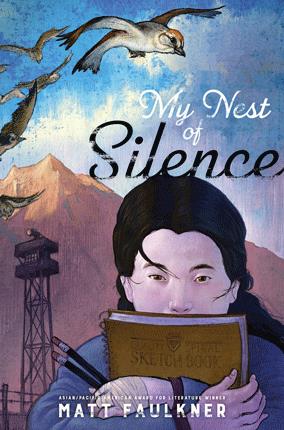| My nest of silence Author: Faulkner, Matt | ||
| Price: $23.78 | ||
Summary:
A graphic novel/prose hybrid which tells the story of a young Japanese American man who leaves his family in the Manzanar internment camp to fight in the European theater during World War II, and of his ten-year-old sister who, frustrated over her brother risking his life for the government that imprisoned them, decides to stop talking until he returns.
| Accelerated Reader Information: Interest Level: MG Reading Level: 3.90 Points: 7.0 Quiz: 518597 |
Reviews:
Kirkus Reviews (08/15/22)
School Library Journal (+) (10/01/22)
Booklist (+) (07/01/22)
Full Text Reviews:
Booklist - 07/01/2022 *Starred Review* After learning of Europe’s Nazi concentration camps as a child, Faulkner also discovered how Americans of Japanese descent were unjustly imprisoned during WWII, a revelation made more urgent because of family connections: his great-aunt Adeline; her daughter, Mary; and Mary’s children were held at Manzanar Relocation Center because Mary’s father was Japanese. Their experience of removal and incarceration inspired Faulkner’s Gaijin (2014); his latest is an impressively fuller account of the Japanese American WWII experience, spotlighting the Asai family held at Manzanar. Ichiro and Aki (Ichiro was Adeline’s husband’s name) are the parents of Mak and Mari (clearly a nod to Mary). Despite Ichiro’s protestations, Mak enlists and eventually serves on the Go for Broke battalion, the 100th/442nd that became the most decorated unit in U.S. military history. Until Mak returns, Mari takes a vow of silence, facing her own fearful battles in camp. Faulkner presents an ingenious hybrid format, assigning the prose chapters to Mari, who writes what she can’t say, while the graphic panels belong to Mak. Faulkner stupendously draws Mak’s experiences as a Japanese American soldier (much of the army’s dismissive, racist behaviors are on full display), and the revealing panels make for a cutting contrast to Mak’s protectively reassuring letters to Mari. Deftly combining the personal and historical, Faulkner alchemizes his extended family’s past into magnificent, essential testimony. - Copyright 2022 Booklist.
Booklist - 07/01/2022 - Copyright 2022 Booklist.
School Library Journal - 10/01/2022 Gr 4–6—It's 1944, World War II is raging on, and in the wake of the attacks on Pearl Harbor, Mari and her family have been interned at Manzanar War Relocation Center for over a year because they are Japanese American. When Mari's brother and best friend Mak turns 18, he joins the U.S. Army, devastating Mari and infuriating his father. Frequently described as "abnormal," Mari takes a vow of silence until either the war ends, or Mak comes home. While her brother is away, Mari tells readers her story through a first-person narrative. She shares her thoughts on her neighbors like the Clucking Sisters and Oba-Chan Yuki and describes daily life in the camp, from art classes with other camp children to lending a helping hand at Manzanar's orphanage. The most important part of Mari's day is whenever she gets the chance to draw. Drawing is her passion, something she can do when the world doesn't make sense and it's a way to relate to others. While away, Mak writes often, regaling her with tales from bootcamp and later on the European front. However, readers catch a glimpse into the reality of Mak's life as a soldier through graphic novel interludes, where black-and-white comic panels bring his true experiences to life. Assigned to an all–Japanese American battalion, he finds every aspect of his enlisting informed by prejudice and discrimination. A combination of narrative fiction and graphic novel, this hybrid delivery of a brave story depicts the Japanese American experience during World War II and will be a hit with reluctant readers. VERDICT At times heartbreaking and other times hopeful, this story of the power of family and ugliness of hate is a first purchase for any library and a must-read for students who enjoy historical fiction or graphic novels.—Maryjean Riou - Copyright 2022 Publishers Weekly, Library Journal and/or School Library Journal used with permission.



